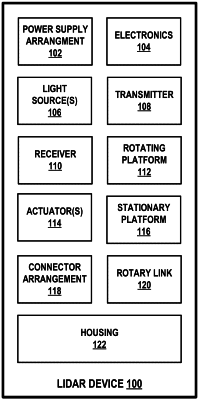| CPC G01S 7/4865 (2013.01) [G01S 17/10 (2013.01); G01S 17/42 (2013.01); G01S 17/931 (2020.01)] | 20 Claims |

|
1. A method comprising:
operating a Light Detection and Ranging (LIDAR) device to emit light pulses in accordance with an emission time sequence and to detect return light pulses in accordance with a detection time sequence, wherein the detection time sequence includes, for each emitted light pulse in the emission time sequence, a corresponding detection period for detection of a corresponding return light pulse, wherein the corresponding detection period is one of (i) a standard detection period having a duration that establishes a nominal detection range for the LIDAR device or (ii) an extended detection period having a duration longer than the duration of the standard detection period;
adjusting the detection time sequence, wherein adjusting the detection time sequence comprises increasing utilization of extended detection periods; and
operating the LIDAR device to detect return light pulses according to the adjusted detection time sequence.
|